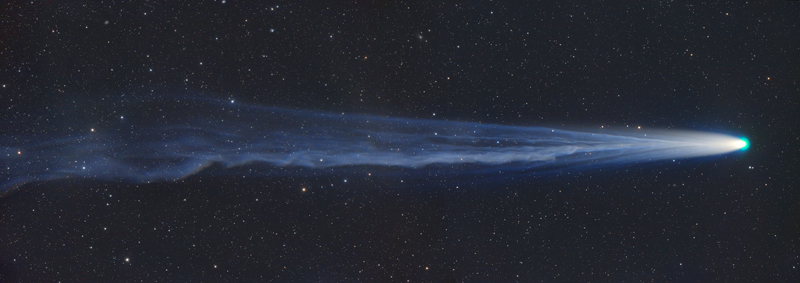Calling those with an interest in photographing the skies, and the backyard equipment to do it; your electricity grid needs you. A forthcoming approach to the Sun by a relatively modest comet could provide an opportunity to learn about the solar wind close to the peak of the Sun’s cycle, and your help is being sought.
Comets bright enough to see with the naked eye only occur every few years (although 2024 could have two), but dozens of fainter comets make their closest approach to the Sun each year. One of these is C/2021 S3 PANSTARRS, and University of Reading PhD student Sarah Watson is looking to take advantage.
Comet PANSTARRS made its closest approach to the Sun on February 14, although at a distance closer to the orbit of Mars than that of Earth it was not much of a Valentine’s Day kiss. The closest approach to Earth isn’t until March 14, however, and even that will be at a distance of around 200 million kilometers (120 million miles) – further than the gap between Earth and the Sun, so there is certainly no need for alarm.
Not being a very large comet, and never getting all that close to either Earth or Sun is hardly a recipe for brightness. C/2021 S3 PANSTARRS is currently around 10th magnitude – barely visible in binoculars – and will soon start to get fainter. That doesn’t mean it can’t be useful for research, nor indeed put on a show if your equipment is good enough.
“When we talk about comets, people often think of a large, bright sphere followed by a long tail,” Watson said in a statement. “The comet we are observing may look different as its tail could ‘detach’ as it is buffeted by solar winds.”
It is this buffeting, rather than the comet itself, that Watson is interested in. She wants photos that show when the head and tail come apart, and by how much. Information about when and where the image was taken will be crucial.
“We need lots of timed photos of the comet to build up a picture of its journey through our solar system,” Watson said. “This is a fantastic opportunity for amateur astronomers to get out their telescopes, capture a truly spectacular cosmic moment and make a big contribution to some important science.”
The comet is only visible for a short time each night, so the more dispersed people trying to supply the images are, the more useful they will be.
It’s commonly believed comets’ tails stream out behind them, but this is not true. Instead, they are carried away by the solar wind, the charged particles of which push against the gas and dust released from the comet. The gas tail points directly away from the Sun at all times, but the dust tail can sometimes be at more of an angle.

Variations in the solar wind can produce this ruffled effect seen in comet Leonard
Image Credit: Gerald Rhemann
Our understanding of solar wind behavior is improving thanks to instruments such as the Solar Dynamics Observatory. We’re even getting warnings of major solar storms’ impacts on the Earth’s magnetic field half an hour in advance.
Given the potential damage such storms could do, it could be very important to manage a little longer than that, and Watson hopes what she learns from the comet will improve the solar winds prediction page she currently runs.
Photographs and the relevant details should be sent to [email protected]
Guides to comet photography can be found online.
Source Link: Calling All Astrophotographers! Your Help Is Needed To Pin The Tail On This Comet